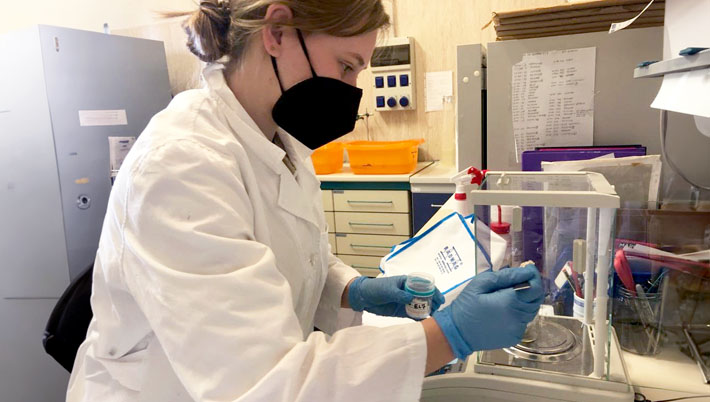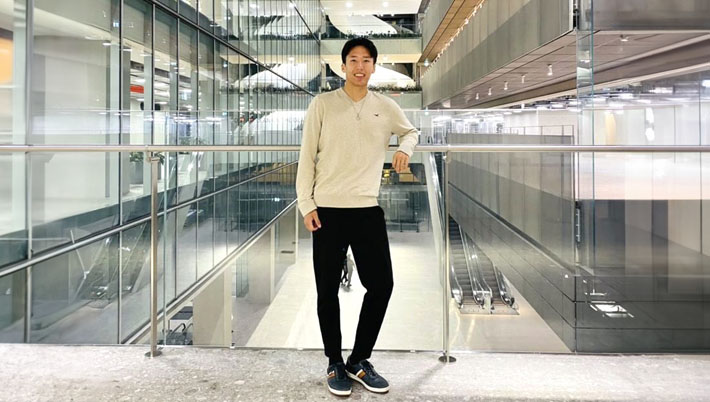There are many things to consider when trying to secure an internship or a job, such as creating high quality application materials, knowing where to look for the best opportunities, acing the interview, and managing the offer process.
Resumes
Employers across many industries expect applicants to have a professional, well-formatted, easy to scan resume. A resume is typically one-page with specified sections, such as education, experience, and skills. A CV (curriculum vitae) is sometimes required by graduate schools or in academia; the CV can be many pages long with much longer descriptions dedicated to research and clinical experiences, publications, and technical skills.
Career Services offers multiple resources to help you develop the best possible resume/CV for your purposes:
- VMock is a platform powered by AI to help you create the most impactful resume. It scores your resume on a scale of 0-100, with 75 being a great target score to achieve. You can use this platform to download a resume template, to find detailed and specific recommendations for improvement, and to make the edits within the platform.
- Our Career Services Mentors (CSMs) offer personalized resume reviews throughout the academic semester. They are available 9-5 M-F and you can drop by the Soll Center whenever it is convenient for you (no appointment necessary).
To access VMock and download the resume template, click here.
To access a CV template click here.
To find a list of helpful action verbs, click here.
Cover Letters
Cover letters are an important part of any written application. We advise all students to submit a cover letter, even if not specified in the application instructions. Why? Because the cover letter connects the dots between your experience and the requirements of the role. It also helps personalize your application, states clearly why you are applying to this role, and addresses any gaps in minimum requirements stated in the job description. You do NOT need to repeat everything on your resume – you are spotlighting a couple of relevant experiences.
Writing a high-quality cover letter takes time because it needs to be customized to the requirements of the role. Never re-use the same cover letter for different roles, since employers can easily spot a generic cover letter and are less likely to invite you to an interview.
Here are the 3 steps to writing a high-quality cover letter:
- Review the job description carefully. Focus on the required skills and experiences. Note the sequence of bullet points (the ones listed first are typically the most important). Identify where your own experiences overlap with the requirements of the job description.
- Research the organization carefully. Gain insider knowledge by talking to as many connections as possible who are familiar with the organization or team. Use LinkedIn – Alumni to identify connections and name drop them in your cover letter.
- Write your cover letter (1/2 to a full page at most).
Format for the cover letter:
- Address – always try to address your letter to its recipient by name. If not available, address the letter to the job title of the hiring manager or the department name. You can even write “Dear hiring manager.” Do not use “to whom it may concern” which is an outdated and generic phrase.
- Opening paragraph – making a positive first impression. Be clear about the role to which you are applying, introduce yourself and make a strong opening statement about why you are excited to apply to this role and/or organization.
- Body paragraph(s) – making a connection between your experiences and the requirements of the job description. Describe 1-2 examples of experiences on your resume that demonstrate your ability to do the role (the key bullets you highlighted in the job description).
- Closing paragraph – making a strong last impression. Summarize why you would be a good candidate. Thank the reader for his/her consideration.
To find examples of different types of cover letters to consider, click here.
Handshake and LinkedIn Profiles
Your Handshake and LinkedIn Profiles are your two most important online recruitment sites. Employers use both sites to identify you as a possible candidate for their internships and jobs. The more sections you complete in these profiles, the more likely that you will be directly contacted by an employer.
Career Services offers workshops on how to complete both profiles and below you can find some useful ideas to get you started.
Handshake Profile Tips:
- Click on your photo or your initials to find My Profile.
- Save time by uploading your resume to auto0-fill your profile with content.
- Include a professional photo.
- Set your profile to be visible to employers, making it easier for them to engage with you.
- Adding a short bio in the “My Journey” section of your profile will allow you to add more of your own voice and personality to the profile.
- Update the “Your Interests” section on your profile to indicate the types of opportunities you’re looking for, location preferences, etc.
Selecting Career Interests on Handshake:
- To ensure you are getting the most out of Handshake and receiving targeted industry information from Career Services, including newsletters, alumni opportunities, and program/event info, update your Career Interests (under your photo or initials), scroll down the page, and check relevant boxes under the section entitled “Check career interest clusters to get targeted information about opportunities.”
To start building your Handshake profile, click here.
LinkedIn Profile Tips:
- Your Name, Photo, and Headline are your billboard – the results that people see when they search on LinkedIn. Your headline should encourage people to click on your profile. Use it to signal your goals and strengths (what defines you). Avoid “Student at Claremont McKenna College.”
- The background photo (horizontal) is an additional piece of real estate where you can highlight your comfort zone or happy place (perhaps a location or work setting).
- The About section is your commercial – the place where you can share details about who you are, your unique/specialized skills and experiences, and your current goals. The summary only displays the first 2 lines, so make sure to capture the reader’s attention in the first sentence.
- The Features section is where you can share posts, articles, links and media to showcase your work and achievements.
- The Experience section is your opportunity to brag. You can copy bullets from your resume and provide links to other media, deliverables and outcomes associated with each experience.
- The Skills & Endorsement section is the searchable list of keywords that recruiters use to find you. Use auto-populated words or phrases whenever possible, since they are the most searched terms on the platform.
- You can customize your personal LinkedIn URL and manage who can see which aspects of your profile.
To find more details about using LinkedIn, including how to find connections on the site, how to apply to jobs, and how to reach out to recruiters, click here.
There are many ways to find internship and job opportunities. Below are a few of the main ways we recommend at Career Services. Remember to always use filters to narrow your search results. In many instances, you can save your search parameters and then set up automated job alerts to make your recruitment more time efficient.
- Over 35,000 organizations are hiring on Handshake it is CMC’s primary resource for connecting students with professional opportunities including jobs, internships, fellowships, and career-related programming. You can access all the opportunities that match your interests here and using the many filters available. You can also follow employers, which means that you will be notified any time an employer adds a posting, event, or makes a change. Please refer to this easy guide for optimizing your Handshake job/internship search.
- You can find opportunities on LinkedIn. These opportunities are open to everyone with a LinkedIn account and are not necessarily targeted at college students. For more information about how to find and apply to jobs on LinkedIn, click here.
- There are a number of niche recruitment sites. Career coaches can advise you on the most relevant sites for you. For a list of the best niche job sites, click here.
- For students interested in opportunities related to government and international relations, Professor Pitney (the Roy P. Crocker Professor of Politics in the CMC Government Department) maintains an amazing website of jobs and internships that link directly to each organization’s hiring page. You can also contact him direct to be added to his recruitment emails, that are filled with alumni-sourced opportunities for internships and jobs.
- Many employers offer recruitment events to our students. These include info sessions, networking events, coffee chats, career fairs, and industry meet-ups. You can register for these events on Handshake by clicking here. For a few tips on how to make the most of meeting an employer, click here.
There are many different types of interviews, all of which have a different purpose. To access an overview of all types of interview you may encounter, click here.
Screening interviews are typically brief meetings in which a recruiter, human resources manager, or line manager assesses your skills and personality traits to help identify candidates who meet the needs of the role. To learn more about how to prepare for a screening interview, click here.
Behavioral interviews are used to assess whether the candidate has the experience and skills required to perform the role. Behavioral questions are used to determine if a person is the right fit for the job, team, and organization. Behavioral interviews are the most common type of interview and typically include a focus on a candidate’s past experiences. The best way to answer behavioral questions is by using the S-T-A-R method. To learn more about how to prepare for a behavioral interview and how to use the S-T-A-R method, click here. To find some typical questions that you can prepare responses to in advance, click here. To find some great final questions to consider asking at the end of the interview, click here.
Case interviews are used to assess the candidate’s problem-solving skills when faced with real business scenarios. They are designed to test the candidate’s analytical ability, problem-solving skills, and grace under pressure. Most case interview questions do not have one “right” answer, so the interview seeks to assess the thought process that the candidate uses. Case interviews are typically encountered in consulting and some financial services interviews. To learn more about how to prepare for a case interview, click here.
Technical interviews are a specialized, rigorous process used to verify the candidate’s coding or other technical skills and knowledge. To learn more about how to prepare for a coding interview, click here and also here.
Employers are increasingly relying on one-way recorded interviews to screen potential candidates. You can practice your recorded interviews using InterviewStream, which you can access via Handshake. To learn more about how to prepare for a recorded interview, click here.
Additional interview prep resources are available via Career Services. These include Yoodli for practicing interviewing questions and getting real-time feedback and Vault Advice Guides (with guides focused on behavioral interviews, case interviews, and finance interviews). Career Services also offers mock interviews conducted by staff and experienced students who can walk you through typical questions and give you immediate and personalized feedback. To set up an appointment for a mock interview on Handshake, click here.
Congratulations! When you receive an offer, always give yourself time to review it carefully and ask questions. You should only accept the offer when you have finished reviewing and negotiating all aspects of the offer. Once accepted, you should stop all further recruitment and interviewing as you are now committed to joining this organization.
The Claremont Consortium follows recruiting policies which are sanctioned by the National Association of Colleges and Employers. These policies request that employers give candidates at least 2 weeks to make an informed and responsible decision. To learn more, click here.
If an employer requires that you respond to the offer sooner than you are ready, we recommend that you inquire about the latest date by which the organization needs a decision. If this latest deadline is still too early for you to be able to respond, the Career Services team can help you figure out the best way to proceed. We can also help you negotiate your offer and reject an offer without damaging your professional relationships at the organization. To make an appointment with a Career Coach, click here.
We have developed a Negotiation guide to talk you through when it makes sense to negotiate aspects of your job offer, what you can negotiate, how to negotiate, and sample emails.
To calculate what portion of your salary will appear in your paycheck, click here.
To estimate your living expenses in a specific city, click here.
To estimate what a competitive salary might be, access our CMC Outcomes data or an external site such as Glassdoor or salary.com or the LinkedIn salary comparison tool.






